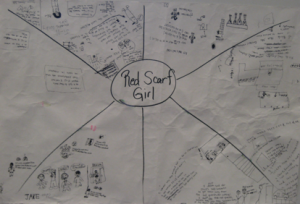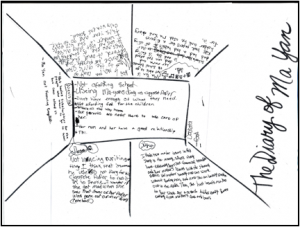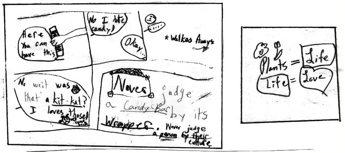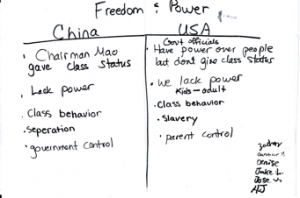Creating a Context for Understanding in Literature Circles
by Amy Edwards, Fifth Grade Teacher, Van Horne Elementary School
My mother always told me that knowledge is power. As a fifth-grade teacher I want my students to gain as much knowledge as possible before they move on to middle school and forget everything as the hormones take over, however, I don’t want them to be dependent on me for that knowledge. As a teacher I prefer the role of “guide on the side” rather than the “sage on the stage.” In recent years I have made great efforts to move from a teacher-centered classroom to student-centered strategies. Probably the thing I most want kids to take from my year with them is a love of literature and to value the experience of reading. Rosenblatt (1938) states that students acquire experience as well as knowledge through reading. Literature provides the experience of “living through,” not just knowledge about, the story world and lives they enter in a book. Reading thus allows students to gain both literary and social perspective. This is what I envision for my students while participating in literature circles. They are immersed in a range of text experiences to build knowledge and understanding that they then hopefully will use to connect to their own problems and needs.
My intention was to start the year by teaching about global issues, since Van Horne’s focus is to effectively engage children with international literature to build intercultural understandings. Through the world of books, students are invited to gain insights into how people around the world think, feel, and live (Short, 2008). I decided to start with literature circles of books that were set in China because the Beijing Olympics had just ended as our school year began. I assumed that with the television coverage, at least some of the students had been exposed to Chinese culture. My expectations didn’t match their experience and this mismatch led to tension throughout our inquiry.
I started the literature circles by reviewing the guidelines for literature discussion since students had participated in them during the previous years. Since this would be their first time discussing literature together with a new group of kids, I knew this step would make the discussion groups go a bit smoother. We had a whole group discussion of a picture book, Ruby’s Wish (Yim, 2002), a book about a little girl in historical China who wanted to go to school. Afterward we debriefed as to how the discussion went and came up with a list of guidelines for literature circle discussions. This list was similar to the guidelines my class used last year, however, I felt it was important for this group to create their own guidelines for discussion so that they had ownership in the process.
The books we read were The Diary of Ma Yan (Yan, 2002), Red Scarf Girl (Jiang, 1997), Chu Ju’s House (Whelan, 2004), and Dragonwings (Yep, 1975). In introducing a new set of books, I always tell students about the authors for each novel so they get a feel for their perspectives. It is important to know the backgrounds of authors and whether they are an insider or an outsider to the culture. I had cut out a few news articles about Beijing; few were about the culture and most focused on the games and how the Americans were performing. I also had a range of books about China, both fiction and non fiction, available for independent reading. Other than that, there was little background building before reading to teach students about the culture.
Each week the students participated in literature circles using several discussion strategies. Some of the strategies for facilitating discussion were Graffiti Boards, Save the Last Word for Me, and Consensus Boards (Short & Harste, 1996). Graffiti Board are where students in a small group respond to literature using pictures or words written randomly on a large piece of brainstorming paper much like graffiti on a wall. Graffiti boards let students respond to a story before and during their discussion. As the discussion unfolds, the events of the story take a back seat to the issues, tensions, and problems that students connect to within a book. I like this strategy because it allows even the most reluctant students to share their thoughts on the paper for all to see.
While listening to the discussions of Red Scarf Girl, I noticed that there was a great deal of confusion about the Cultural Revolution in China. The time period was a bit of a mystery to my students. In the forward, the author explains that the Cultural Revolution started in China in 1966 but that 17 years earlier, in 1949, the revolutionary leader Mao Ze-dong led the communist party to power as the new leaders in China. This important information was missed by some students because they skipped the forward, thinking it was not important to the story. I quickly realized that I needed to sit down with this group and talk about the difference between democracy, which we were learning about in social studies, and China’s government, communism, which they were unfamiliar with. What I didn’t realize at that time was the extent of their confusion about historical China as compared to contemporary China. I also noticed that students were spending so much time puzzling through what was happening in the book that they were not as engaged with the issues and ideas as I had expected.
After responding to the story by adding to their graffiti boards several times as they continued reading chapters, they looked for issues they saw as significant in the books. They identified these on a consensus board. On a large piece of paper with sections for each, they individually listed the issues that they felt were important in the text. They then had to come to consensus about what they all thought were the main issues in the book and list those in the center of the consensus board.
After the groups completed this discussion, we charted the issues found by each group as a class. The issues that students identified across the novels about China were:
• gender preference
• population-one child limit
• adult/child relationships
• lack of resources for families: $ and time
• sick parents
• child abuse
• lack of political freedom
• drug abuse/violence
• equal education opportunities for girls and boys
• care of elderly
• racism
• hunger
As I read through their list of issues from the books about China I became worried that the students thought China was a terrible place. I didn’t want to demonize Chinese culture because of misperceptions brought about by reading these historical novels. I wanted the students to realize that at least some of these problems existed in our country historically as well and so asked them to look at the same issues in the United States. In small discussion groups, students chose one issue and created T-charts listing the problems related to this issue and whether or not these issues were exclusive to China or also appeared in the U.S., either now or historically. We then shared in a whole group setting. Through this experience, students realized that these problems were found in the U.S. as well as China. The issues the four groups chose to compare with the U.S. were:
• hunger
• homelessness
• violence
• freedom and power
A common problem with international studies is that students assume that the target country still exists in the past. It is difficult to find current, up-to-date, contemporary texts on many cultures and countries. This was true throughout this study. There were a lot of misconceptions about contemporary culture in China. Students were discussing events as if nothing had changed in China since the 1960s and the Cultural Revolution. Students needed to realize that much had changed in both the U.S. and China since 1966. For instance, one of the issues that came up in several of the novels was that children were disciplined using corporal punishment. Students couldn’t believe that kids were hit by adults as a means to teach them how to behave. We discussed how children at our school are currently disciplined and that sometimes they are asked to take a time out or “Think Time” in a special location in the room, an adjoining room, or the office. I explained to the students that in my school years, small slaps were administered by adults to children who misbehaved. Robert confirmed this practice because his dad had shared that if you were swatted at school, usually the parents followed up with the same discipline at home just to make sure you got the point. We talked about the fact that what is considered appropriate changes over time in all societies throughout the world and that we no longer consider it appropriate to slap or swat a child in school. Since most of our books were historical, this practice could have changed in China as well. Robert pointed out that maybe someday in the future sending kids to other rooms for “time out” won’t be considered a good thing to do to kids.
The issue of hitting children also came up in the Diary of Ma Yan, a contemporary story about China. This story takes place in rural China as does Chu Ju’s House where children who are living in an orphanage are hit as a form of discipline. In thinking things through, students realized that changes in attitudes sometimes take place slower in rural areas than in cities.
To challenge some of their misperceptions about contemporary China, I invited a Chinese doctoral student from the University of Arizona, Ke Huang, to visit our classroom to discuss the present day culture. I wanted the students to be able to interview an insider to Chinese culture to counter some of the stereotypes I was afraid they were developing. The students asked many questions especially about her experiences with school and childhood in China. They asked about some of the issues they were seeing in the literature and she was forthright in answering tough questions about population control, corporal punishment, and governmental philosophies. She knew about the time period of the Cultural Revolution, but was too young to remember it. This was a valuable addition to the unit and Ke was an amazing resource.
Near the end of the literature study I searched for articles on contemporary China through the Scholastic web site. I found some interesting pieces appropriate for fifth graders on issues such as population control, China’s need for hydro-electric power and the resulting damage to the environment, governmental shifts from communism to free trade, and gender issues. Students read and discussed these short pieces in small groups and shared the big ideas and information with the whole class. This experience gave students a much better understanding of Chinese culture, both in the historical setting of the novels and in contemporary times. In fact, students were fascinated with understanding communism and it became a topic of interest throughout the school year. Some of the students even went snooping to the end of the Social Studies textbook in chapters on the Cold War and Vietnam. They did this again and again and found other texts that mentioned communism on my nonfiction shelves. They had created a context for the ideas behind communism and wanted to know more.
In reflecting on this experience, I felt positively about the ways in which these engagements challenged the misconceptions and stereotypes my students were developing through their discussions in the literature circles. I felt tension, however, about the need to counter their misconceptions and wondered what I could have done differently in setting up this inquiry.
Many times I pull sets of related texts, maps, newspaper articles and other artifacts related to the critical issues or the geographic area of study to enhance the experience for the students. I hope these artifacts will spark an interest in some aspect of the culture. I don’t want to pre-teach the concepts, but build experiences and knowledge so the students can puzzle through the text while building their own meanings and understandings. Rosenblatt (1938) states that background materials often receive too much attention and can become an end to a means. She feels that background knowledge has value only when students feel the need for it and when it is assimilated into a student’s experience with a certain piece of literature.
It had not crossed my mind that I needed to immerse this new group of students into texts about China and the Cultural Revolution before reading these novels. All but one student had been at Van Horne and had worked with concepts of internationalism and culture for two years. I made the mistake of thinking these new kids had the background, experience, and connections that my previous class had left with in May. I felt they didn’t need the additional information and that their experience with the novels could be damaged by giving away too much before reading. I wanted them to glean the information about China and the Cultural Revolution from reading, not be spoon fed the ideas from the teacher. Looking back I realize I could have helped them understand better if I myself had known more about the topic before getting started. In other words, I could have done my homework a bit more thoroughly.
Sylvia Edgerton is a teacher who believes that the more she knows about a topic the more her students will learn (Smith, Diaz, & Edgerton, 2008). Before she starts an inquiry unit she reads newspaper articles, views video clips from the internet, watches the nightly news to increase her awareness of state and federal legislation that might be related to the topic, and interviews anyone who might be knowledgeable about the topic that are getting ready to study. During the study she deliberately plans reflective activities so students can have opportunities to revisit texts and make connections between and among them.
The problems encountered during our literature circles on China taught me firsthand to consider the experiences with a range of texts that students might need both ahead of time and during the study. In this case, they needed ways to more effectively build a context within which they could construct meaning and explore issues from novels. Smith, Diaz, and Edgerton (2008) believe exposure to multiple texts helps build connections and deeper intertextual understandings. They describe intertextuality as the ways that texts — whether written, visual, or spoken — are interpreted, one in light of the other. Intertextuality is more than trying to find a personal link while reading or connecting one text to another. It is a cognitive strategy that, linked with intentional thinking, can progressively transform readers and their understandings. They believe this collection of texts should be explored both at the beginning and throughout an inquiry-based study. As students explore multiple texts in multiple settings they spin a web of understanding. Connections are then made from student to student and text to text, creating layers of meaning and new understandings.
After working through the struggles that students had with the concepts and issues in the books relating to China, I am now considering when to prepare kids ahead of time for reading a particular set of novels and when to just immerse them in the novels and let them figure them out the confusions on their own. I now know that I need to continuously struggle with the balance between supplying experiences and texts before literature circles and letting students make their own meaning during the study with intertextual materials that facilitate connections gained through dialogue with other students and between texts. Clearly, there is no one right way to approach this balance and I need to know the literature and my students to make these decisions with each new set of literature discussions.
Our first literature experience of the year wasn’t a failure from a teaching and learning standpoint because I learned a few things about my students and my teaching. It was a learning experience I didn’t expect but nonetheless was still very valid. Students learned that they can’t judge another place by its history and realized they needed to challenge their assumptions and recognize that other countries are not still operating in the past. One of the most valuable things they learned was how to sustain themselves as readers even when they don’t understand the content. They may not have engaged in the in-depth discussions of issues that I had hoped would emerge from these novels, but they learned to puzzle through and develop valuable understandings and knowledge from confusing texts. I know that the knowledge they gained was powerful for them because of this struggle. Tension provided a generative point of learning, both for me and for my students, even though that learning was not what any of us had originally intended.
Professional References
Rosenblatt, L. (1938). Literature as exploration. New York: Modern Language Association.
Smith, K., Diaz, S. & Edgerton, S. (2008). Making inquiry intentional and intertextual. School Talk, 13(3), 1-8.
Short, K. G. & Harste, J. (1996). Creating classrooms for authors and inquirers. Portsmouth, NH: Heinemann.
Short, K. G. (2008). Exploring a curriculum that is international. WOW Stories, 1(2), http://wowlit.org/on-line-publications/stories/storiesi2/?page=5
Children’s Literature References
Jiang, J. (1997). Red scarf girl: A memoir of the Cultural Revolution. New York: HarperCollins.
Ma, Y. (2002). The diary of Ma Yan: The struggles and hopes of a Chinese schoolgirl. New York: HarperCollins
Whelan, G. (2004). Chu Ju’s house. New York: HarperCollins.
Yep, L. (1975). Dragonwings. New York: HarperCollins.
Yim, S. ( 2002). Ruby’s wish. Vancouver, Canada: Raincoast.
WOW Stories, Volume I, Issue 3 by Worlds of Words is licensed under a Creative Commons Attribution-NonCommercial-ShareAlike 4.0 International License.
Based on a work at https://wowlit.org/on-line-publications/stories/storiesi3/.





One thought on “WOW Stories: Connections from the Classroom”
Comments are closed.